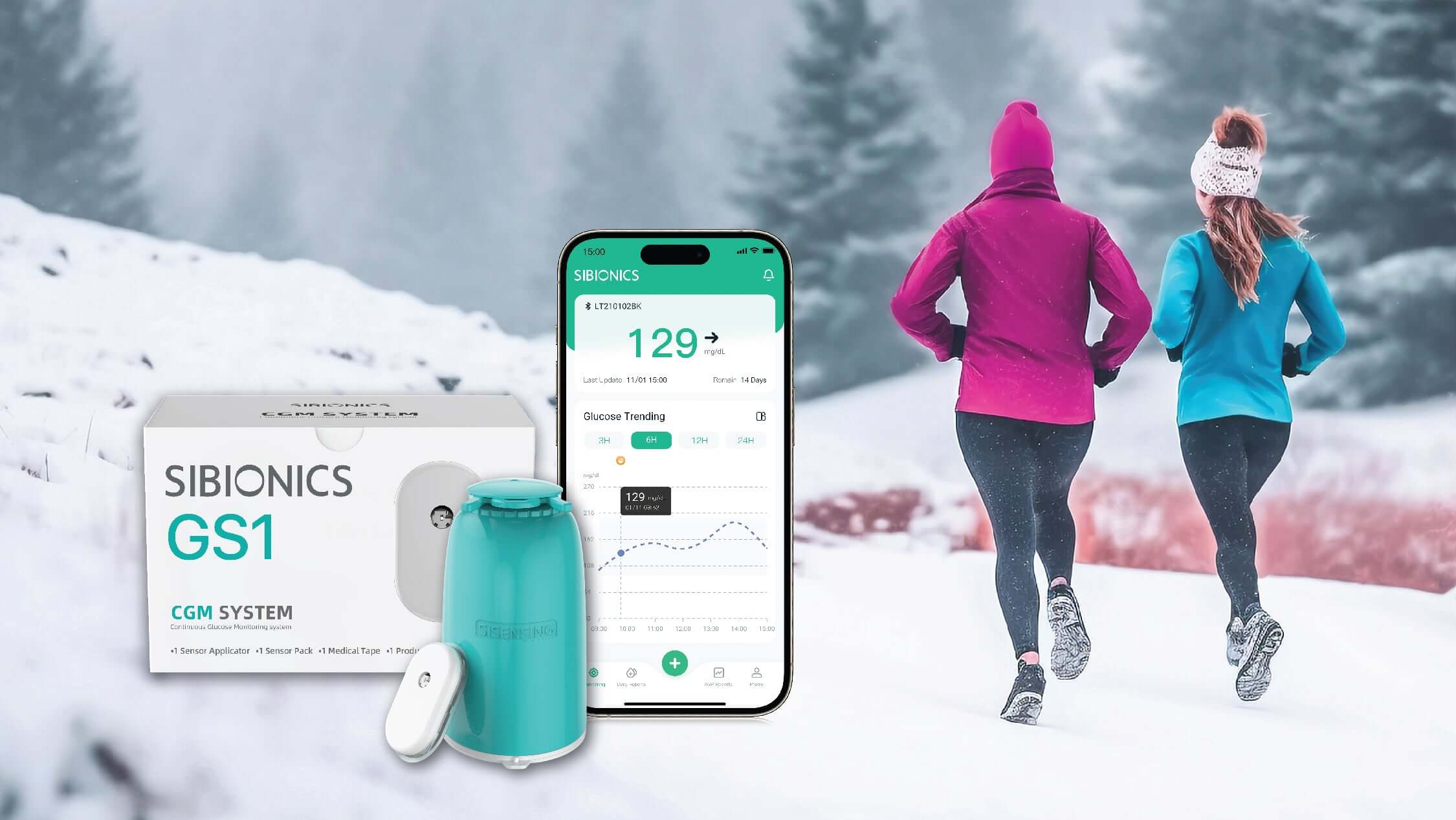Have you ever thought about the impact of outdoor temperatures on your glucose levels? If so, your intuition is correct: extreme temperatures have the potential to unsettle your glucose. Typically, glucose levels tend to be lower during the summer and higher in colder temperatures. During the winter season, people with all types of diabetes are more prone to experiencing elevated HbA1c levels compared to the warmer months. As the cold sets in, your glucose levels can truly become erratic. With this in mind, we’ve gathered a few useful tips to help you regulate your glucose levels amidst a cold spell.
Stay Warm
Cold temperatures contribute to vasoconstriction, the narrowing of blood vessels, which may hinder the smooth flow of blood to your extremities. For people living with diabetes, compromised blood circulation can exacerbate existing complications and increase the risk of frostbite or other cold-related injuries. Especially when you’re using a traditional glucose meter or CGM that requires daily fingersticks or calibrations, you’ll need to warm your hands first before testing your glucose. Performing frequent fingerstick tests in cold temperatures imposes an intolerable emotional burden, as the cold will make your fingers more sensitive to pain.
To alleviate this constant pain, you can opt for a fingerstick-free and calibration-free CGM, like the SIBIONICS system, which offers real-time glucose level monitoring for up to 14 days. Additionally, wearing layered clothing and appropriate winter gear, such as insulated gloves, and well-fitted waterproof footwear, can help to protect your extremities from the cold.
Monitor Glucose Levels Regularly
Consistent glucose monitoring is the cornerstone of effective diabetes management, and the winter season underscores the importance of this practice. Winter's unique challenges may require adjustments to your insulin dosages or other medications. The freezing weather can also trigger our body’s physiological responses, such as releasing more stress hormones, which may lead to elevated glucose levels.
Physical activities like shoveling snow can also affect glucose, by increasing it through exertion or causing a rapid drop due to prolonged exposure to the cold temperatures. Understanding these dynamics is crucial for people with diabetes, their caregivers, or their healthcare team. Luckily, the SIBIONICS CGM system provides real-time continuous glucose monitoring. The glucose insights, including trends, daily reports, glucose alerts, and more, collected from this CGM device, will not only free your fingers from frequent pricking but also help you make informed decisions about your diet, activity, and medication.
Stay Active and Exercise Indoor
Maintaining a fitness routine can help us with weight loss and glucose control. In colder months, lots of people tend to be less active. After all, curling up with a fluffy blanket and a cup of hot tea sounds much more comfortable. The cold can seriously deter one from their morning runs, particularly during those frigid days. But if you do enjoy exercising outdoors, make sure your glucose levels don’t drop too low due to the cold temperature.
We do not encourage people with diabetes to expose themselves to the wintry outdoors for a long period because the cold will further destabilize their glucose levels. So keep your exercises inside the house. From aerobic workouts to yoga, staying active indoors is not only achievable but can also be enjoyable. Even VR exercise games like Beat Saber and Holopoint will help keep your muscles moving in the comfort of your living room.
Plan Healthy Winter Meals
The cold weather often triggers cravings for hearty, indulgent “comfort food” that may be rich in carbohydrates and sugars. Holiday gatherings, filled with traditional feasts, can also present tempting but potentially problematic dietary choices. Acknowledge these challenges and their impact on your glucose levels, more importantly, stick to a moderate portion and keep a close watch on your glucose levels if you decide to indulge yourself.
Regardless of the season, it’s always recommended that you consume natural, unprocessed foods and snacks modestly. Optimally, try to incorporate more fiber-rich foods, such as lentils, and green peas into your diet. Replace ready-to-eat takeouts with homemade meals that comprise more complex carbohydrates, non-starchy vegetables, lean protein, and healthy fats. Looking for more detailed recipes and cooking ideas? Check out this 7-day diabetes-friendly meal plan.
Hydrate Effectively
Dehydration causes your glucose levels to rise. Contrary to popular belief, cold weather doesn't reduce the body's need for hydration. Factors such as your indoor heating systems, which lead to drier air, and outdoor activities like playing in the snow, may contribute to increased fluid loss. Therefore, it's advised that you stay hydrated throughout the winter season.
Protect Your Feet
Reduced blood circulation to the extremities puts those living with diabetes at a greater risk of foot-related complications. The constriction of blood vessels and the decreased sensation can make the feet more susceptible to issues such as frostbite and dry skin.
Be cautious about exposing your feet to extreme cold. Take special foot care by wearing warm, breathable socks, and well-fitted, insulated footwear. Inspect your feet daily for any signs of cuts, blisters, or abnormalities.
Get Your Flu Shot
Becoming sick makes diabetes management more difficult. For people living with diabetes, contracting the flu virus means they’ll be left with less energy and a worse appetite, and the worst part is that their sugar levels can rise significantly higher, which may trigger some serious complications. If you have experienced severe flu symptoms in the past, consider getting yourself an annual vaccination before the virus prevails. Even after the flu season starts, it’s beneficial to get vaccinated. Keep illness out in the cold by eating healthier meals, keeping warm, and tracking your glucose levels with a CGM.
Store Your Supplies Properly
Proper storage of your diabetes supplies, such as insulin, is essential for ensuring their potency. If you’re using insulin to manage diabetes, then you’ll know freezing and near-freezing temperatures destroy insulin molecules, therefore, you should never leave your insulin out in a parked car overnight. It’s also a good practice to use insulated cases for your insulin and oral medication while traveling to maintain the integrity of these supplies.
Prepare a diabetes care emergency kit and conduct regular inventory checks. This kit should contain regular supplies such as continuous glucose monitors, insulin, syringes, and any necessary oral medications. Store up some extra supplies when you’re alerted of an incoming winter storm near you. Furthermore, make sure your emergency carbohydrates like juices and glucose gels are well stored at a suitable temperature and easily accessible.
Speak with Your Healthcare Professionals
Navigate the winter season with a diabetes care plan that is specifically tailored to address the challenges of the colder months. Have open discussions with your diabetes team about winter-specific concerns, such as adjusting insulin dosage to account for the changes in physical activities and dietary choices.
Managing diabetes is a team effort, especially when it comes to interpreting your AGP reports. If you’re new to CGM devices, you may find it difficult to understand the complicated graphs and numbers appearing on your AGP reports. However, with the necessary help from your healthcare providers, you’ll gain a more clear interpretation of your AGP reports. That’s why the SIBIOINICS app allows you to download and email your AGP reports to healthcare professionals with just a simple tap.
Be Mindful of Mental Health
The winter blues, also known as Seasonal Affective Disorder (SAD) can cast a shadow on your mental well-being. Sadly, these seasonal mood swings may disrupt your diabetes management efforts, leaving you with unstable glucose. It's important to recognize and manage your emotional triggers, whether they're the reduction of daylight, the gloomy and frigid weather, or self-reflection during the holiday season.
Safeguard your mental health by doing some physical activities, listening to relaxing music, reading, or practicing meditation. You can also reach out to your family and friends, or have an online chat with someone living with diabetes, too. Having a good talk with people who understand and support you can significantly lift your spirits.
Wrapping Up
As we conclude, it's crucial to revisit the key tips above, which form the foundation of effective diabetes management when the temperature drops. First and foremost, maintain stable glucose levels by paying close attention to dietary choices, continuous glucose monitoring, and adhering to your medication plans, staying adequately hydrated, and storing your diabetes supply kits properly. Wear insulated winter gear to protect your extremities from freezing. Also, keep depression at bay and do things that will make the winter a bit more bearable. Finally, make it a priority to have regular check-ins with your diabetes team to ensure that your treatment plans remain tailored to your needs.









